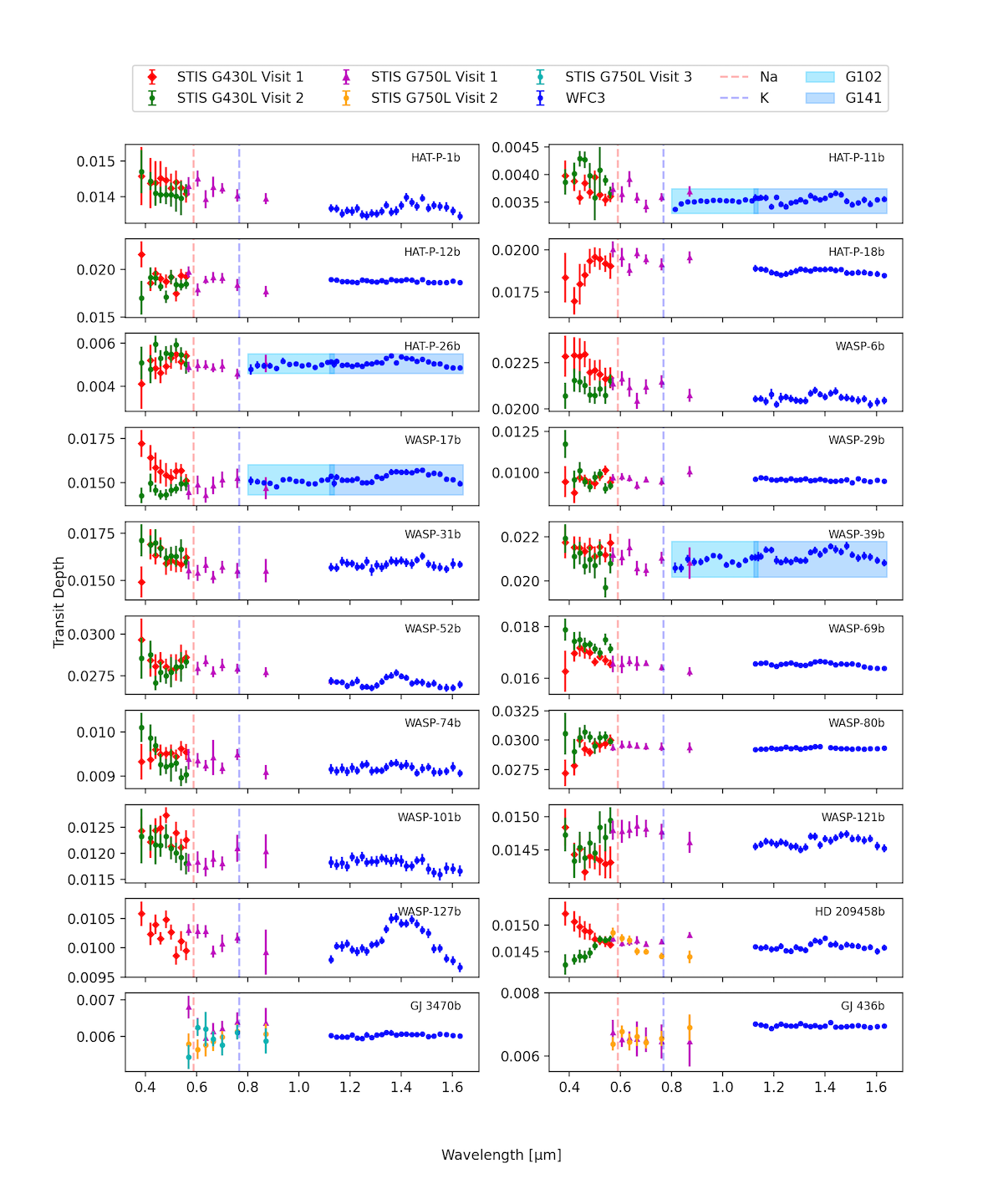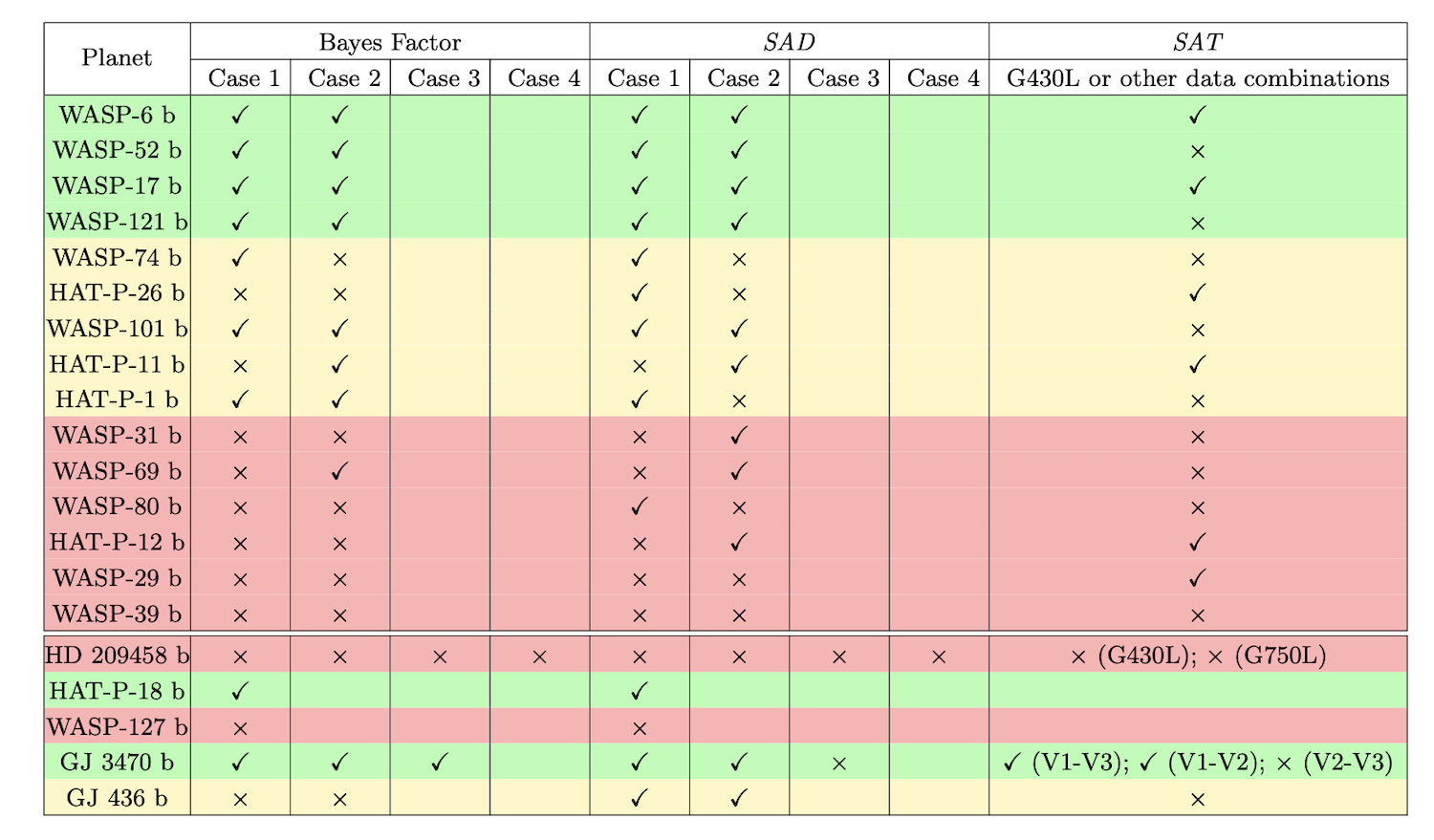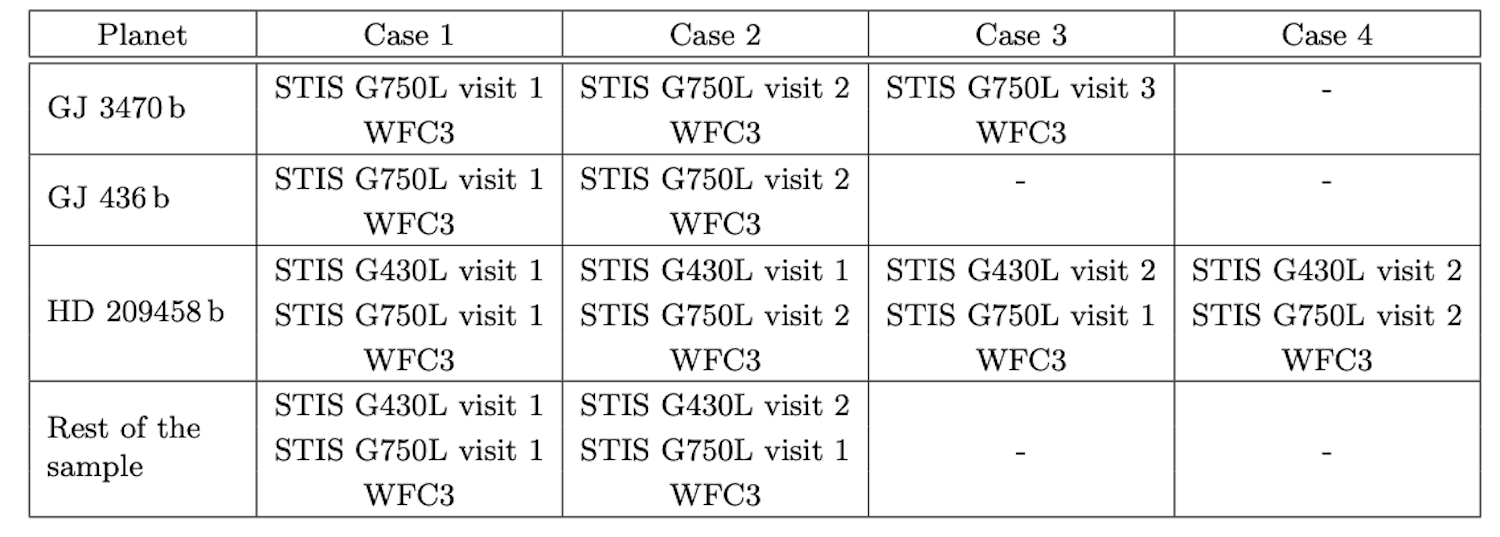A Population Analysis of 20 Exoplanets Observed from the Optical to the Near-infrared Wavelengths with HST: Evidence for Widespread Stellar Contamination
- UCL, Physics and Astronomy, United Kingdom of Great Britain – England, Scotland, Wales (arianna.saba.20@ucl.ac.uk)
We present a population study of 20 transiting exoplanets, currently the largest sample of exoplanet atmospheres observed to date in the spectral range near-UV to near-IR. Archive data obtained with Hubble STIS and WFC3 instruments are uniformly analysed using the Iraclis pipeline and a suite of spectral retrieval plugins integrated in TauREx 3.1, including the stellar activity plugin ASteRA and the cloud microphysics plugin YunMa. Most exoplanets included in the sample were observed multiple times with the STIS G430L and/or G750L gratings (Fig. 1), allowing for the study of temporal variability caused by changes in the exoplanet atmosphere, due to e.g. cloud/haze variability and/or stellar magnetic activity.

Fig. 1: The spectral data resulting from our data analysis, colour-coded based on the observation timestamps of each STIS visit. The dashed lines centred at 0.59 μm and 0.77 μm indicate where we expect the peaks of the absorption features of sodium and potassium to appear respectively.
Our analysis reveals significant differences among the observations obtained with STIS at various epochs for about half of the planets included in the sample. These data show amplitudes and patterns that are suggestive of time-varying stellar surface heterogeneities that cause contamination in the exoplanetary spectra. At a population level, our analysis reveals that for planets on which stellar activity exerts the most significant influence on their spectrum, even employing the simplest stellar contamination model is sufficient to align water abundance values to the average of the whole sample.
To statistically assess the preference for an active model over a quiet star model, we compute the Bayes Factor resulting from the difference in Bayesian evidence between two retrieval models: one model representing a primary atmosphere with water vapour as the sole opacity source, assuming a uniform stellar photosphere, and the other incorporating the same atmospheric model but considering the star to have a heterogeneous surface. Despite the active star model being statistically penalised for its increased complexity compared to the simpler model, it remains significantly favoured across many spectral cases. This result emphasises the critical nature of accounting for the potential presence of unocculted stellar spots and faculae when performing spectral retrievals in the optical regime. Among the total number of targets investigated, nearly half of them exhibit a strong preference towards the model incorporating an active star, while only one planet strongly favours a quiet star.
Furthermore, we establish new, complementary metrics to assess the extent of stellar activity contamination; the Stellar Activity Distance metric (SAD) and the Stellar Activity Temporal metric (SAT). The SAD, by corroborating the findings of the Bayes Factor analysis, indicates that an active star model better describes the optical observations in approximately half of the planetary spectra. Similarly, the SAT results reveal a bimodal distribution, indicating that spectral variations in the visible regime within this limited planet sample are either minimal or moderately significant.
We analyse in more detail three case studies: WASP-6 b, WASP-39 b and HAT-P-11 b. Our findings align with previous literature results for the first two planets, for which we find an active stellar environment and a quiet star respectively. However, HAT-P-11, expected to be active, is found to show no significant signs of stellar contamination. Across the population, stellar activity contaminates up to half of the studied exoplanet atmospheres albeit at varying extents (Table 1).
Table 1: For each planet, we report the preference (✓) or rejection (×) for stellar contamination based on the metrics outlined in our investigation. The 15 planets with consistent sets of observations are ordered based on their ranking within the sample over all of the metrics from most likely to be contaminated (WASP-6 b) to least likely (WASP-39 b). Colour coding reflects the consensus among metrics: green signifies unanimous or nearly unanimous indications of significant activity; yellow denotes uncertain outcomes, with some metrics leaning towards stellar activity and others against it; red indicates a preference for an inactive star. The 5 planets that do not have consistent data sets are reported separately below the main table. They are not included in the ranking but are colour coded in the same way. For an explanation of the data sets considered in each Case, see Table 2.

Table 2: Data sets utilised to define each Case number. Each STIS visit indicated here is colour-coded in Fig. 1.

Overall, our findings demonstrate the significant role that stellar contamination may have in all exoplanet spectra observations: therefore, comprehending, modelling, and correcting for the impact of stellar activity is important for a complete characterisation of exoplanet atmospheres. This issue becomes particularly relevant with the ongoing JWST observations of small planets, statistically more likely to orbit active stars. Additionally, addressing stellar activity becomes even more pertinent in anticipation of the extensive chemical surveys to be conducted by next-generation space telescopes in the coming decade. For these reasons, targeted campaigns aimed at investigating the activity of exoplanets' stellar hosts through time would significantly contribute to the success of the exoplanet field.
How to cite: Saba, A., Thompson, A., Yip, K. H. (., Ma, S., Tsiaras, A., Al-Refaie, A., and Tinetti, G.: A Population Analysis of 20 Exoplanets Observed from the Optical to the Near-infrared Wavelengths with HST: Evidence for Widespread Stellar Contamination, Europlanet Science Congress 2024, Berlin, Germany, 8–13 Sep 2024, EPSC2024-171, https://doi.org/10.5194/epsc2024-171, 2024.